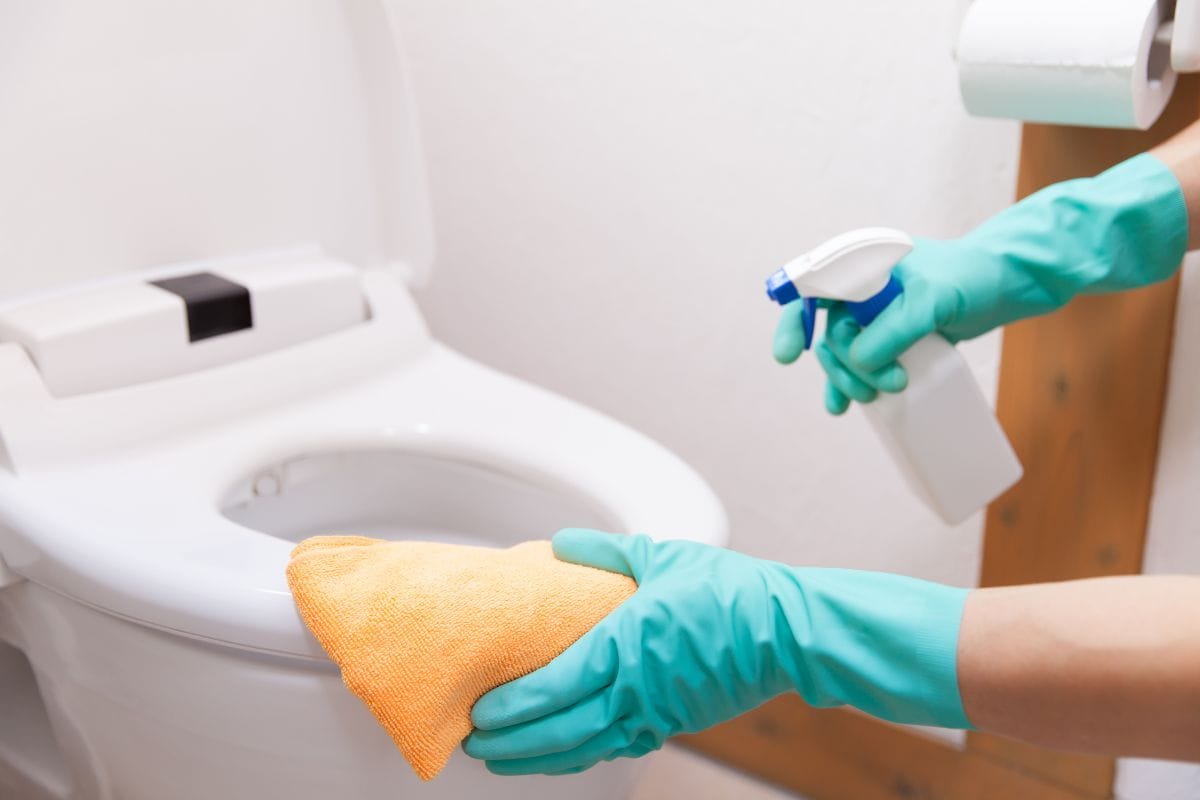A really unpleasant chore is cleaning the toilet. Even if it’s not difficult, mistakes might still happen. Despite popular belief, there is a proper technique to clean a toilet, and using it correctly can assist guarantee that you get rid of any germs and viruses that may be growing there. So, the question is, How to clean toilet seat?
To begin, spray the non-bleach spray solution up and beneath the seat and the lid. Allow it to sit for one minute. Then, using a clean sponge, cleanse the seat. Repeat as often as required.
Every aspect of the solution to clean the toilet seat that you could be looking for has been addressed by us. So remain with us to find out more.
How to Clean Toilet Seat
Regular toilet cleaning will keep hazardous germs, unsightly minerals, or dirt buildup away. To do so, keep the necessary supplies on hand at all times.
Things You’ll Need
So, what tools to clean the toilet seat? Some simple tools are listed below:
- Waterproof rubber gloves
- Scrub sponge
- Toilet cleaner or vinegar
- Toilet brush
- Disinfecting wipes
- All-purpose disinfectant spray
- Cloth or towel
- Pumice stone
- Rags
- Paper towels
To keep these items apart from the rest of your cleaning goods, keep them in a tote or bucket. Cleaning the sink with the toilet sponge or washing dishes with the same rubber gloves is not a smart idea. Furthermore, they are inexpensive and readily accessible at any hardware store.
Steps to Follow
And, here’s the step-by-step guidance on how to clean the toilet seat.
Step 1: Make the toilet bowl clean and sanitary

Drain the water from the dish first. You can accomplish this by plunging the toilet or turning off the water supply and flushing the toilet. A cleaning agent and a long-handled angular brush can be used to clean the toilet bowl thoroughly.
Allow the cleaner to rest on the inside rim for a while. After that, use a toilet brush to clean the toilet bowl. Never combine bleach and acid. To rinse the cleanser, flush.
Make careful to continue rubbing while the water drains. The toilet seat may also be cleaned and scrubbed with the same detergent.
Step 2: Clean the Outsides of a Toilet and the Toilet Seat

Cleaning should be followed by disinfection. Put the lid on and spray the back and edges with a disinfectant. Pour it also on the toilet seat. Make sure the lid’s bolts and hinges are covered. To clean the challenging nooks and crannies, grab an old toothbrush. Utilize paper towels to remove the filth.
Apply an appropriate disinfectant spray liberally to the toilet’s tank, lid, sides, and base. Never combine bleach and acid.
Clear it off. Begin from the top and work your way down. Use a microfiber cloth or a cotton cleaning rag. Change the rag and keep going if the fabric becomes too wet in the middle.
Step 3: Cleaning the Base of a Toilet
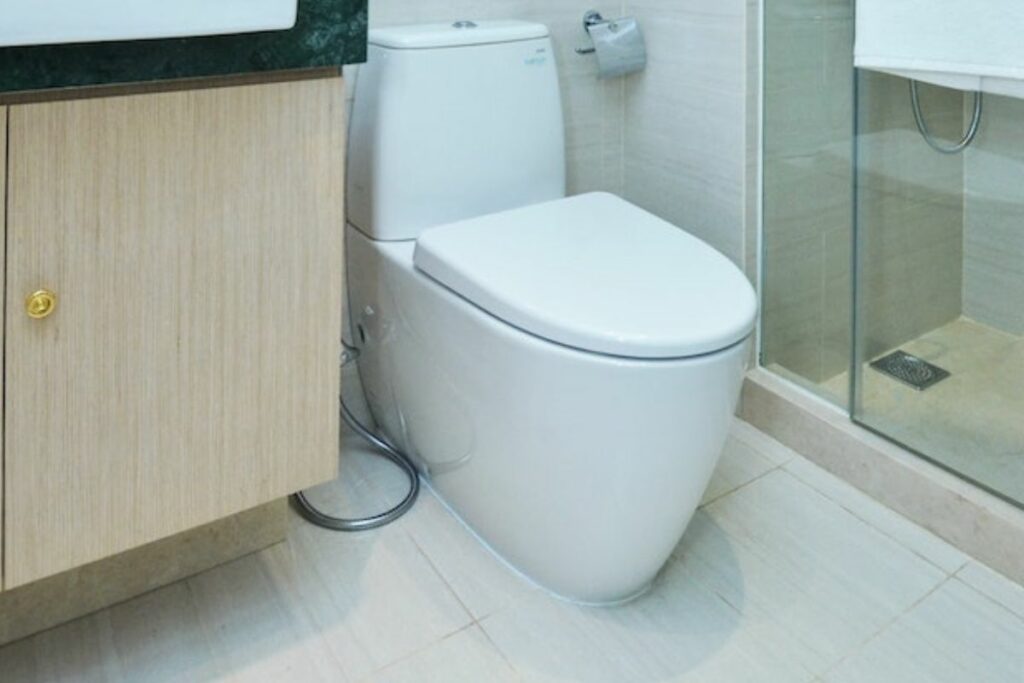
The base of a toilet is the part that is connected to the floor at the bottom. This surface also has to be cleaned often to maintain hygiene. The base of a toilet may be cleaned with a vinegar and water mixture. You should mix 2 cups vinegar with 1 cup water.
After completely swirling the mixture with a stirrer, pour the solution into a spray bottle. After thoroughly spraying the base, let it sit for 20 minutes. Give the area a thorough rinse after giving it a good scrub with a sponge pad.
Step 4: Remove Hard Water Stains
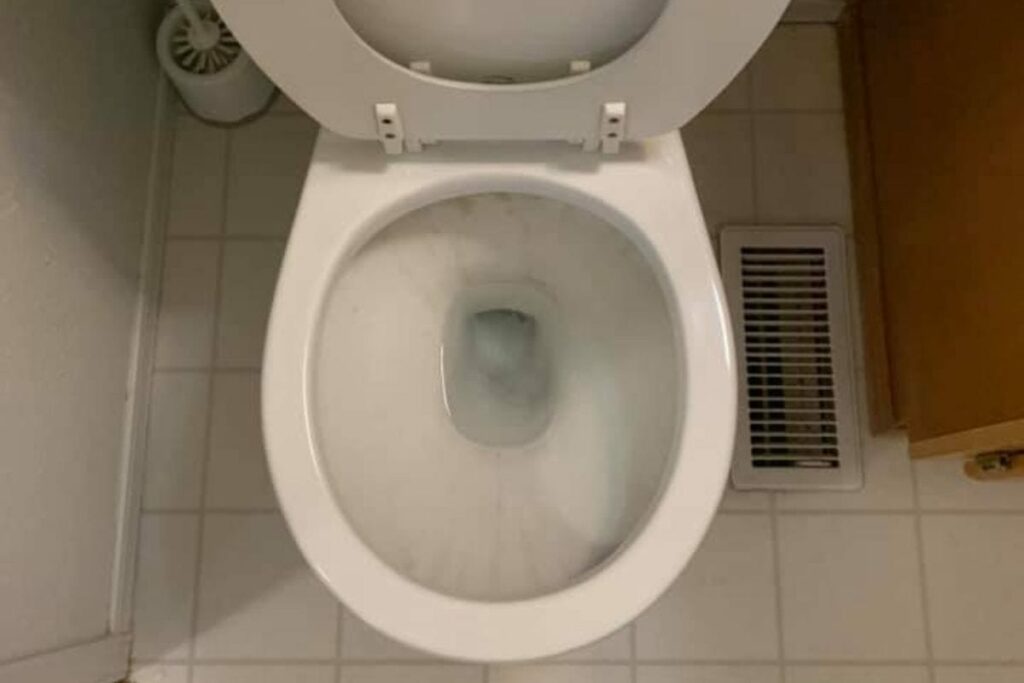
Pour 1 cup of vinegar into the bathroom sink. Wait for a minute. Using a toilet brush, coat the bowl with vinegar. Add one cup of baking soda and one more cup of vinegar at this time.
Give them five minutes to respond. To remove the yellow hard water stains from your toilet bowl, use a toilet brush to scrub the interior and rim of the bowl.
Step 5: Get Rid of Yellow Stains from the Toilet Bowl
Sprinkle a lot of baking soda over the discolored area to get rid of yellow stains from your toilet bowl. Scrub the surface now using the brush.
Next, apply 1 cup of vinegar by spraying it over the discolored area or pouring it over it, and let it sit for 20 to 30 minutes. Rinse with water thoroughly. If necessary, repeat the procedure.
Step 6: Get Rid of Brown Spots from your Toilet Bowl
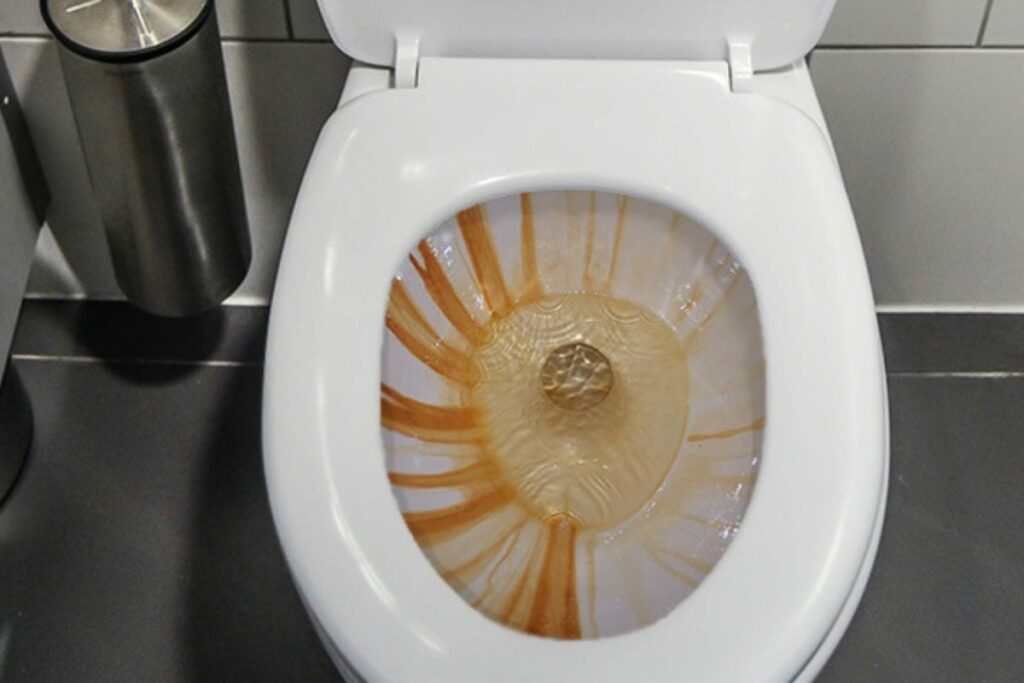
Rust or iron oxide deposits on your toilet bowl are what generate brown stains. Pour 2 liters of vinegar into the basin and left it there for a few hours or overnight to cure these areas. Make a paste out of salt and vinegar if the brown stains on the inside of your toilet bowl rim start to form.
Make use of an old toothbrush to apply this paste to the locations. Give the paste three to four hours to dry in the places. Flush it out afterward.
Step 7: Clean the Toilet Brush
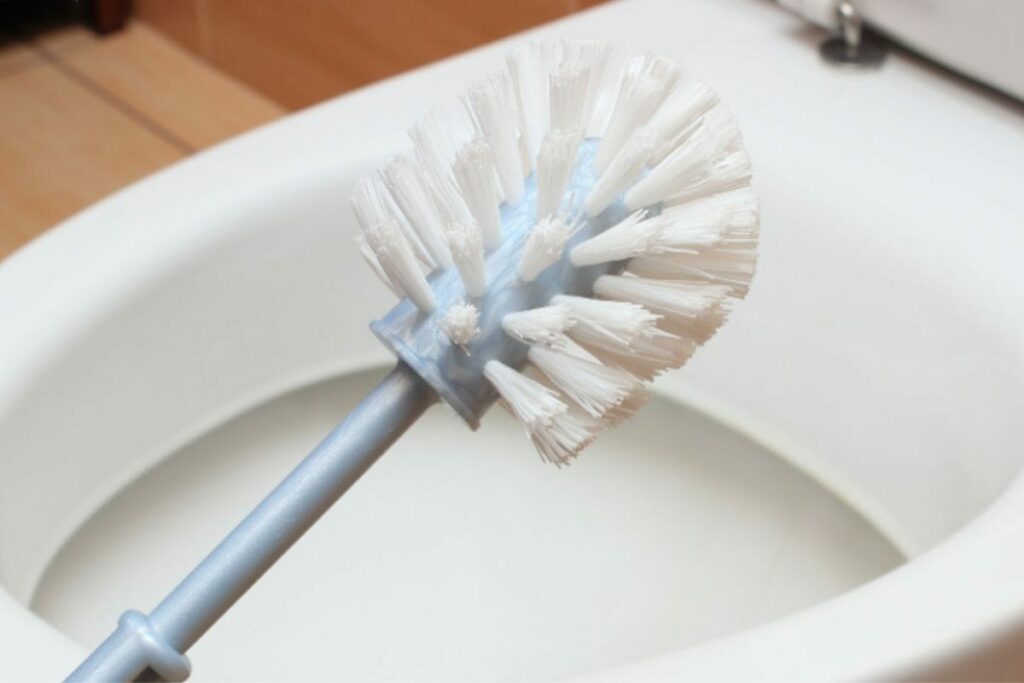
The best method for cleaning your toilet brush is to give it a hot water rinse, spray it with a powerful disinfectant, then let it in the sun for a while after usage.
You now understand how to remove toilet stains. You may clean your toilet with natural substances as well. Please be aware, though, that certain natural substances, such as lime juice, vinegar, and baking soda, might not be powerful enough to eradicate pathogenic microorganisms. Utilizing a commercial toilet cleaner liquid is recommended.
However, we advise you to read the product’s warnings and usage instructions before using the product. When using bleach, always use protective hand gloves and a mask.
How to Clean Toilet Seat Hinges
A dirty toilet is one of the least attractive features in a bathroom. Even if the bowl, seat, and tank are routinely cleaned, hair, dust, and debris can still gather and deposit a coating of filth around the seat hinge. Two bolts, one through each seat hinge, secure the toilet seats in place.
A plastic cover often covers these bolts to conceal them. The majority of the filth is trapped in the cover, which is simple to reach and clean just as completely as the rest of the fixture.
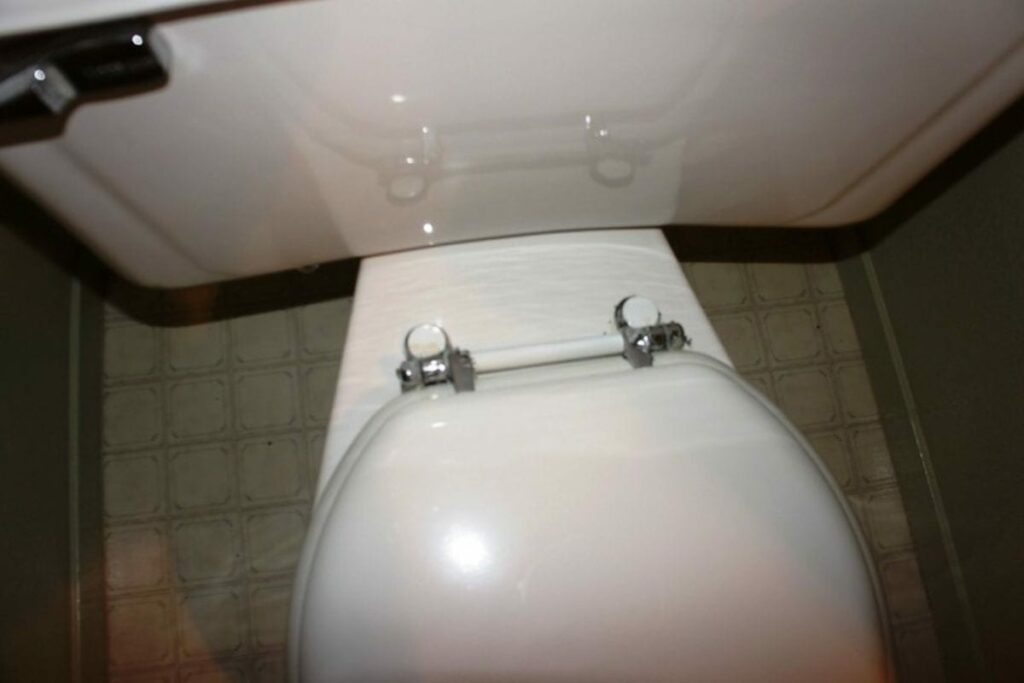
- Close the lid as well as the toilet seat. This allows you to easily reach the hinge at the back of the lid.
- Remove the hinge cover made of plastic. Depending on the model of your toilet seat, you may need to pull it loose with your fingers or a screwdriver. If it’s the latter, insert the flat side of the screwdriver under the hinge covers and lift them up to uncover the screws.
- If you’re in a hurry, simply wipe the now-exposed hinges. If you have the time and energy, remove the screws that hold the seat’s cover to the toilet bowl. Remember to remove the bolts from the seat’s underside.
- To make a paste, use one part vinegar and two parts baking soda. Alternatively, a mild scouring scrape might be used. Apply the paste to the open hinge and the hinge base.
- Scrub the hinge region with scouring paste and a soft-bristled brush to avoid scratching the porcelain or the hinge, which is often made of plastic. An old toothbrush works nicely and can easily slide around the hinge components.
- Clear water should be used to rinse away the scouring substance. Close the hinge cover after wiping the interior of the hinge dry.
- For further oomph, soak the toilet seat cover in a bowl of 10% bleach solution for 10 minutes. This destroys all bacteria on the surface while also improving its luster.
- Wipe it clean with a moist towel when the 10 minutes are up to remove the bleach solution. This leaves the toilet seat gleaming clean and fragrant.
- Using the scouring paste, clean the exterior of the hinge and the surrounding toilet rim. Wipe dry after rinsing with clean water.
Mistakes to Avoid When Cleaning Your Bathroom
While cleaning a toilet may appear to be an easy and obvious operation, there are various blunders that may be made. Here are some mistakes to avoid to guarantee that your efforts are not in vain.
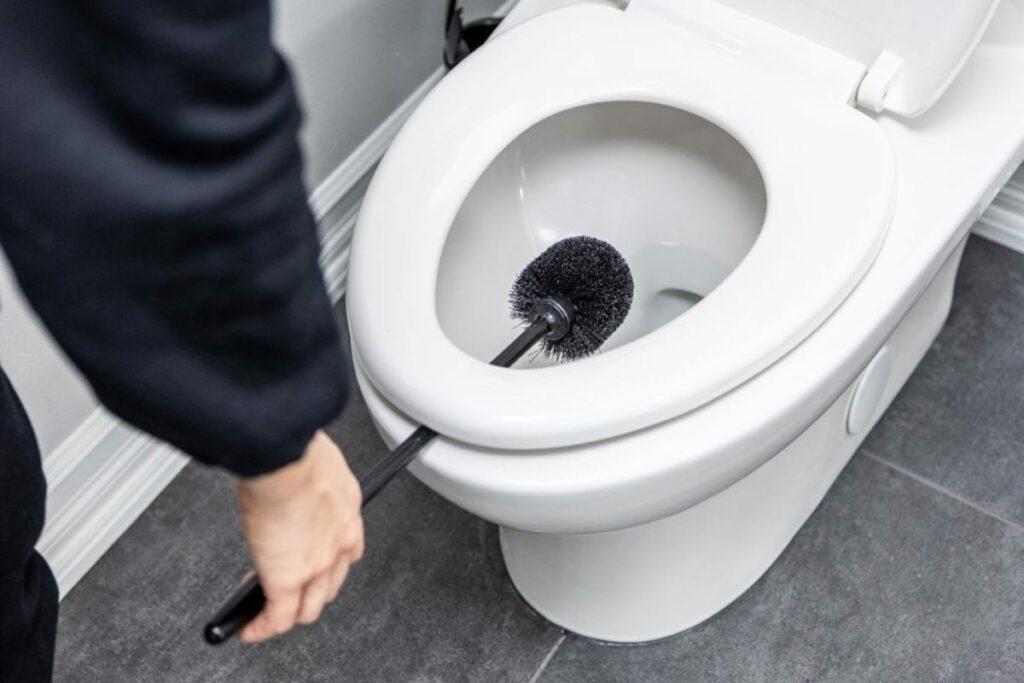
- Most people immediately place the toilet brush back in its cradle after cleaning the toilet. You’re merely making a pool of soiled toilet water that you’ll be dipping into if you don’t let it dry first. Always let the water from your toilet brush fall into the bowl after drying it under the seat of the toilet.
- If you don’t dust before cleaning the toilet, you’ll likely leave a moist path of dust on the surface. To prevent making this error, use a duster or your vacuum cleaner to remove dust. You may always employ professional apartment cleaners to handle the work for you.
- Not cleaning behind the toilet is a common omission. Nobody likes to stretch to reach between the toilet’s back and the wall. If you don’t, dust and hair will build up over time.
- Baking soda and vinegar are both good cleansing agents, but using them together can negate the disinfecting benefits of vinegar. First, make use of baking soda’s scouring strength. Scrub it in your bathroom sink with water and a sponge. Then, utilize vinegar’s antibacterial abilities to destroy germs by spraying it on washroom surfaces.
FaQs
How frequently should toilet cleaning be used?
It’s a good idea to clean your toilet whenever it’s obviously unclean, but as a general guideline, you should plan bi-weekly, or twice-weekly, cleanings because this plumbing fixture contains the most bacteria and germs.
What is the best way to use a toilet cleaner?
Pay attention to how your toilet brush appears before you do anything. Once you’ve got the correct brush in your hand, start by applying the toilet cleaner to the bowl as near to the top as you can. Allow it to soak for a few minutes after that. While it’s soaking, use a disinfectant to clean the exterior of the toilet. Next, clean the exterior of the toilet with a scrub sponge. After cleaning the exterior, clean the bowl with a toilet brush. He adds that if you have hard water stains, a pumice stone might help remove them.
Is it okay to use toilet bowl cleaners in septic tanks?
Toilet bowl cleaners and cleaners with bleach or chlorine in them are to be avoided or used sparingly if you have a septic tank. They might cause your septic tank to back up if you use them excessively. Look for sodium hypochlorite or chlorine bleach on product labels. These can pollute your drinking water, create septic tank backups, and emit unpleasant odors.
Conclusion
Have you found an answer to the issue ‘How to clean toilet seat?’
We hope you’re answering yes now that we’ve covered everything there is to know about the subject. Now, you should agree that cleaning the toilet seat isn’t that hard but requires carefulness. You’ll enjoy the results as long as you’re patient in selecting the appropriate tools and using them correctly!

Amos Christen graduated with a bachelor’s degree in Interior Design from Drexel University — Philadelphia, PA. Since 2003, Amos has worked with top interior design professionals in this area, including architects and interior/graphic/lighting designers. As a skilled interior designer, Amos Christen is highly versed in fine arts and crafts and uses that to supplement his main area of expertise. He often publishes articles related to home décor on several websites, including Sprucetoilets.com, Sprucebathroom.com, and Mybesuitedhome.com. He also contributes to leading interior design magazines.
